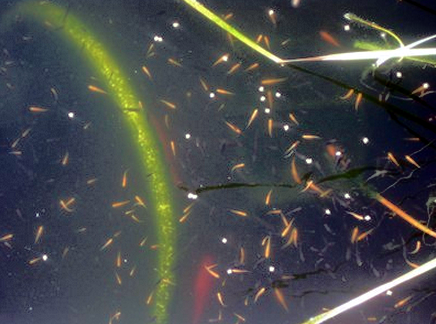The Basics of Koi Fish Breeding: Part II
Koi fish breeding can boost your pond’s population and extend the lifeline of your koi. Breeding takes many steps and can be costly, but if you’d like to grow more koi for your pond, or maybe even sell them, koi breeding may be for you. Once they reach a foot long they can be worth about $100 each. With your koi producing so many eggs, the amount of money you wish to make just depends on how much space you have to raise the koi.
Continued from The Basics of Koi Breeding: Part I
Once the eggs have been released and fertilized and the female koi is tiring, remove the male koi before he eats all of the eggs. He can be placed back in the pond. At this point, remove the spawning brush, grass, mats, or whatever medium used in the breeding tank. The fertilized eggs are attached to these materials and are visible to the naked eye. You will see many eggs at this point.
Make sure that the water in both tubs are the same temperature to ensure a smooth transition for the eggs. Koi eggs are very vulnerable to not only their parents and other pond predators, but also to inconsistencies in water levels. Once the eggs are placed in the nursery tank, double check ammonia levels in the water, which may have been altered from the protein in the egg sacks. If ammonia levels are off, do a partial water change over the course of an hour.
You can leave the female koi in the breeding tank alone for a while to rest. Spawning is hard work and she will be tired. If she’s placed back in the pond, other males will respond to pheromones and try to breed with her, which may damage the female koi. Leave her to rest and recuperate for 24 hours before returning her to the pond.
Until they hatch, the baby koi will feed off their own embryos. You won’t need to worry about feeding them at this stage, and because you’re not feeding them water should remain relatively level. Eggs that were never fertilized will turn white and fuzzy, while fertilized eggs will become clear. With a close look, you may be able to see the two eyes developing in the baby koi. Remove the unfertilized eggs from the tank.
Depending on water temperatures, the fertilized koi eggs will hatch within 3-7 days. Keep a close watch on the eggs during this time. They develop a sheen about a day before the eggs hatch. You can watch the baby koi move inside the eggs as they prepare to escape.
Once the baby koi, or koi fry, have hatched they attach to the sides of the tank for a few days. Soon they will swim to the surface and can begin eating solid foods. Soon they’ll grow up and you’ll have a whole new generation of koi fish! You can read more about koi fry here.
Do you have tips on koi fish breeding? Share them with us and our readers! Post a comment or tell us via the contact form.







